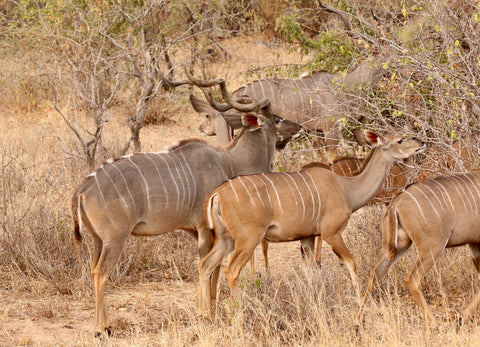You have no items in your shopping cart.
Kudu, Tragelaphus strepsiceros, are one of the most graceful and beautiful antelopes and are treasured by any conservationist. They run in small herds and breed once a year. They are roughly 1.5 meters tall at the shoulders. They live in the wood savanna of central Africa and are not aggressive at all, tending to run away when threatened, even when injured.

Kudu are browsers feeding on leaves and shoots. Where human has decided to plant tobacco, Nicotiana tabacum, on extensive plantations the Kudu have learned that the growing tips of the tobacco make an easy and very nutritious food source. They will walk up a line of tobacco plants nipping off the top growing tip of the plant. This then reduces the number of leaves available for harvesting and reducing the returns available to the planter.
A similar situation occurred with wheat and barley plantations. These are planted in the winter when the cooler weather allows their cultivation in Africa and are irrigated resulting in a lush, tempting source of food. Browse is naturally short in the long African winter when no rain falls and leaves fall off the trees. This again is a prime source of food that the Kudu took advantage of to the detriment of the farmer.
Early solutions involved employing labour to patrol the areas and scare the invaders off. Unfortunately, there were others who preferred to shoot the Kudu and this caused a population collapse. A conservation body was able to put a stop to this practice but the issue of protecting the product remained. Initial attempts to erect fences were not successful as a kudu will easily clear a 2 meter fence and even if they hit the top wires their weight carried them through, destroying the fence in the process.

Early attempts to electrify the fence proved of doubtful effectiveness as the Kudu do not inspect a fence to enable it to receive an electric shock. They would simply jump over a fence. This attitude is common with Impala and Springbok who will both easily clear a 2m fence. (This was found later to be true of Red Deer in the UK) It was only in the 1980’s when an idea to try baiting them on to the fence was tried. This involved tying a lump of absorbent material to the fence and soaking it with an attractant liquid. The premise being that the Kudu would sniff the bait with its nose which is wet and often use the tongue – both of which contain many sensitive nerves which generate a strong sensation and imprint on the animals mind. Animals have been seen reacting strongly away from the fence once they have had a try of licking a bait source.
-
Pain: Electric shocks from these fences can cause a sharp, stinging pain at the point of contact. The intensity of the pain on sensitive nerve endings on the nose or tongue can be strong.
-
Tingling or numbness: After touching an electric fence, the animal experiences tingling or numbness in the affected area due to the disruption of nerve signals.
-
Psychological impact: The surprise and pain of an electric shock can be psychologically distressing, leading to anxiety or fear of approaching the fence again.
This proved extremely successful and has been utilized in many situations where a target is difficult to control.





← Older Post